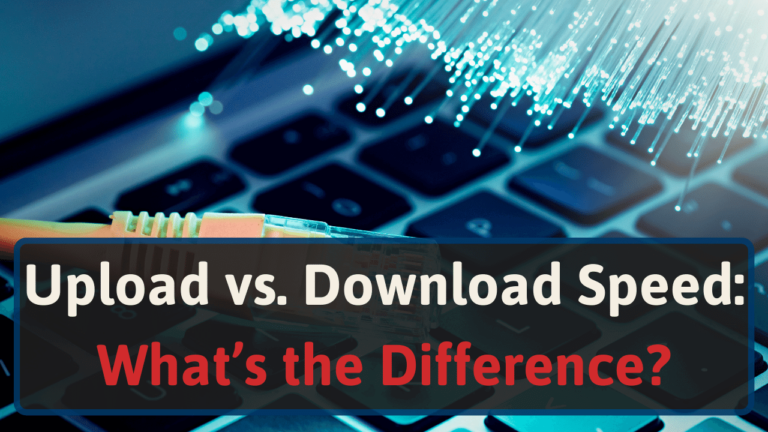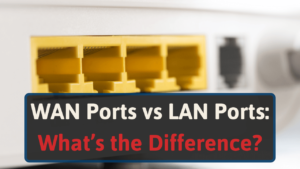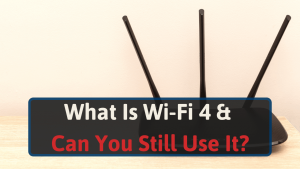I’ve been exploring uploading and downloading to find out how these speeds will affect users. We’ll be looking at the following subjects in this article:
- The key differences at a glance
- A closer look at upload and download speed
- Which speeds you’ll need
- When upload and download speeds will differ
- How to measure your speeds
- Whether it’s possible to improve your speeds
Let’s get started.
Upload Speed vs. Download Speed At a Glance
Here are the key takeaways on the matter:
- Downloading is more intensive because of streaming, browsing etc.
- Upload speed is used for emails, video calls etc.
- DSL, cable and satellite download speeds are generally 10x higher than upload speeds
- Fiber internet offers equal download and upload speeds
- Your speed will be capped by your internet service provider
A Closer Look at Upload and Download Speeds
Download speed refers to how quickly information is received from a server to your local device. This could be movies, music, web pages or other.
Upload speed is how quickly that information is transmitted from your device back to the server. That could be sharing information with someone else, gaming, video calls etc.
It really is as simple as that! We simply measure the speed at which the data moves in either direction.
Both speeds are typically measured in Mbps but you might also see the format as MB/s. These refer to the same thing.
The difference? Just the scale. 1 MB/s is 8 Mbps [1]. The only reason they made the change is so internet service providers could get their speeds to look more impressive!
Here are a few of the key things one would use uploading and downloading for:
| Uploading | Downloading |
| Sharing files | Receiving files |
| Video and audio call output | Video and audio call input |
| Gaming | Gaming |
| Streaming movies and music | |
| Internet browsing |
As you can see, downloading is likely to be more bandwidth intensive than uploading. Streaming movies and music takes up a lot of bandwidth for most families.
Which Upload and Download Speeds Do I Need?
In the table below, you’ll find some of the most popular uses for uploading and downloading and an idea of the upload and download speeds required for each activity.
| Activity | Upload Speed Required | Download Speed Required |
| Streaming movies and music | N/a | 0.5-25 Mbps (although could be up to 100 Mbps for 8K) |
| Video calls | 0.5 to 5 Mbps | 0.5 to 5 Mbps |
| Audio calls | 0.06 to 0.1 Mbps | 0.06 to 0.1 Mbps |
| Gaming* | 0.5 Mbps to 10 Mbps | 3-50 Mbps |
| Sharing files | 111 Mbps to upload a 100 GB file in 2 hours | 111 Mbps to download a 100 GB file in 2 hours |
| Internet browsing | N/a | Up to 10 Mbps |
*The higher bracket of these figures refers to competitive, professional gaming. For most people (and most games), closer to the higher bracket should suffice.
Based on this information, I can say that the following speeds will be okay for the following people. However, please note that there are a lot of variables that will affect where you sit in this table. It really depends on what you like to do on the internet at the end of the day.
| Max Speed | Who It’s Best For |
| Up to 25 Mbps | May cause issues even for a single user |
| 25-50 Mbps | Enough for one or two people |
| 50-100 Mbps | Enough for a small or average-sized family |
| 100-200 Mbps | Enough for a large family or a small business |
| 200-500 Mbps | Enough for a small or medium-sized business |
| 500 Mbps | Enough for medium and large businesses |
Which Upload Speed and Download Speed Will I Have?
Firstly, you’re going to want to find out what internet plan you’re on. You’ll never be able to get a faster download or upload speed than the cap you’ve been allocated by your internet service provider.
It also matters whether you have fiber internet or regular DSL, cable or satellite, so you’ll need to find this out too. There’s a couple of key differences between the two technologies.
Firstly, fiber is generally faster. The technology has less restrictions and therefore data can move more freely and more quickly.
Also, most fiber plans have ‘bilateral’ upload and download speeds. This means your upload and download speed will be around the same with fiber internet.
The other main types of internet are DSL, satellite and cable, which are older technologies in the residential domain. With these, your upload speed is likely to be around just one tenth of your download speed allocation.
That is unless your speed is less than 100 Mbps, as upload speeds seldom drop below 10 Mbps.
Most people in the US right now will have cable internet, or perhaps DSL or satellite. These were the main type of internet in the US until fiber began to roll out to residential users.
Those in more rural areas are still likely to have one of these technologies. Each of them has slightly different performance but the bottom line is that they’re not ideal anymore.
In fact, the more rural you are, the slower your speed is likely to be. DSL, satellite and cable internet can range from less than 1 Mbps to 100 Mbps or more. Anything less than 25 Mbps is likely to be quite restrictive even for a single person, as we found out in the previous section.
Fiber for the future
Fiber is a relatively new technology and internet service providers are rolling it out across as much of the US as possible as we speak. But that’s a lot of land, so it’s going to take some time. Plus, the infrastructure is pretty expensive.
That’s why right now, it’s more likely that people in cities will have fiber. Many people in rural areas will be stuck with slower speeds.
In the future, hopefully, we’ll all have fiber internet. It’s cheaper to maintain and cheaper for us customers too. Plus, it’s faster in both directions. What more could you want?
How To Test Your Upload and Download Speeds
To find out once and for all what your upload and download speed are, the best thing to do is run a test. It’s super quick, free of charge and you can do it right away.
In this article, we compared some of the best online speed test sites out there. Any one of them will give you the information you’re looking for and more.
Just make sure that you disconnect all other devices before you run the test. Any other internet activity on the network will affect your bandwidth. Even if a device is idle, it could be performing updates or syncing data which will lower the test speed.
I also recommend getting close to the router when you run the test. If you’re in the next room, you’re probably going to be getting slower upload and download speeds than when you’re right next to the router.
If something doesn’t look right, stay tuned for the next section as we find out how to get the best out of your home upload and download speeds.
How To Improve Your Upload and Download Speeds
Getting quicker upload and download speeds at home might not be as out of reach as you might think. Here are a few quick tips that may help you better your home online experience:
- Check your internet plan: Your internet speed is never going to be faster than the speed cap set by your internet service provider. So, find out what this is and if it’s not enough, reach out to see if they can upgrade you.
- See if you can change provider: There’s likely to be more than one internet service provider in your area. You can always take a look to see if one of the other providers can offer something faster.
- Move closer to the router: If your router has poor signal strength or you live in a large home, it may just be your distance from the router that’s impacting your upload and download speeds.
- Disconnect other devices: All connected devices could be having an impact on your network bandwidth, so disconnect devices you’re not using to maximize your speed.
Still need help? We go into further detail and provide more tips in our ultimate guide to fixing your internet speed here.
Upload Speed vs. Download Speed FAQ
I’ve been hearing the following questions regarding upload and download speeds. And, I’ve answered them below.
Where does latency come into all this?
Download and upload speeds aren’t the only important figure in the internet world. Some internet processes will require you to consider your latency as well. You can find out more about what that means here.
What are the fastest upload and download speeds in the US?
The fastest download speeds these days will all be fiber. That means (as we now know!) that
Right now, the fastest home fiber plan is some 6 Gbps. That’s 6000 Mbps! That’s probably going to be a little excessive for most people. Soon, it’ll be 8 Gbps [2].
What do I do if I can’t get fast internet access in my area?
Unfortunately, there isn’t much you can do other than relocate…
Wrapping Up On Upload and Download Speeds
Your upload and download speed define what you’ll be able to do with your home internet connection, and how easy those things are to do. Without a decent download and upload speed, you might find yourself struggling to do the things you love online.
Now that you know the difference between the two, you can get a better idea of what kind of speeds to be targeting. Be sure to check out our guide on improving your speeds above if that’s what you’re looking to do.
In the mood to boost your internet speed right now? Fiber customers might want to pick up a new router. You can find out our best routers for fiber internet here.







